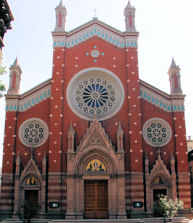
Latest News
New openings
The Zeyrek Cistern is opened to visits after years of restorations.
Entrance fees
As of 2026, Palace museums' entrance fees are raised.
Museum Pass
You can buy the "Museum Pass" for foreigners which is valid for 5 days in various museums of Istanbul.
Museums open 7 days
Many State museums in Istanbul operate 7 days a week, except Topkapi Palace.
Christian churches in Istanbul
Around 98-99% of Turkey is Muslim, that leaves only 1-2% for Christians and Jews, mostly concentrated in Istanbul with their churches or synagogues having a legal status. Some of the major Christian churches in Istanbul are below:
The Saint Antony Church

The Saint Antoine Church (San Antonio di Padova) is located on Istiklal Street in Beyoglu, on the left side of the street if you are facing from Galatasaray towards Tünel. The church was built between 1906-1912 by architect Giulo Mongeri, who was born in Istanbul, gaving it an Italian Neo-Gothic style. Today it is Istanbul's largest church with the busiest congregation and is run by Italian Catholic priests. The Church was built in a courtyard, and the entrance of the church is on the main street between two apartments which were built to raise money for the church.
The Bulgarian Church
This church belongs to the Bulgarian minority and is the most interesting church in Istanbul. The Bulgarian minority of the Ottoman Empire used to pray at the churches of the Fener Orthodox Patriarchy. Due to the nationalistic movements, Bulgarians were allowed to build their own church in the 19th century. First, a small wooden church was built on the shore of the Golden Horn between Balat and Fener squares (near Eyup district) where the current church is located, but later this was developed into a larger building. An iron frame was preferred to concrete reinforcement due to the weak ground conditions. The construction plans were prepared by Hovsep Aznavur, an Armenian of Istanbul origin. An international competition was conducted to produce the prefabricated parts of the church, and an Austrian firm, R. Ph. Wagner, won the competition. The prefabricated parts were produced in Vienna and transported to Istanbul by ship through the Danube and the Black Sea. After one and a half years work, it was completed in 1898. The main skeleton of the church was made of steel and covered by metal boards. All the pieces were attached together with nuts, bolts, rivets or welding. The architectural styles come from the Neo-Gothic and Neo-Baroque periods.
The Greek Orthodox Patriarchate
The Patriarchate is the highest see and holiest center of the Orthodox Christian Church. It's located in the Fener neighborhood near Eyup district, between Sadrazam Ali Pasa Street and Incebel Street, the Greek Orthodox Patriarchate is located in the yard of this church. In 1602, the Patriarch moved to Aya Yorgi, when the site was used as monastery. Since that time, several renovations have occurred, the most recent of which ended in 1991, owing to damage sustained by fire in 1941. Although not so significant architecturally, Aya Yorgi possesses valuable historical artifacts. Among the most significant are: a patriarchs throne from circa 5th century; three samples of rare mosaic icons; a column which is believed to have been used for the binding and flogging of Jesus in Jerusalem; and cascades belonging to three women saints.
Surp Kirkor Lusarovic Armenian Orthodox Church
It is the oldest Armenian church of Istanbul located in Karakoy district. It was written in a manuscript that there was a church there in the name of Surp Sarkis in 1360. It was rebuilt in 1431. Since it was fell down in 1958, architect Bedros Zabyan built a new one. It is one of the churches which was built during Turkish Republic period. Its conical dome differs it from other Armenian churches. In the crypt there are some nice tiles deriving from the previous church on the site.
Virgin Mary Suryani Church
It is the only church which was built by Suryanis (Assyrian) in Istanbul. It was built in Beyoglu - Taksim district in 1960 with the stones brought from Mardin where the head church of Suryanis is located. The Assyrian generally use churches that they either rent or borrow from the other denominations. There are also other sections in the church such as a school and an administration office.
Anglican Church
It was also called Crimean Memorial Church. It was built behind the Swedish Consulate in Beyoglu - Taksim district, on the land donated by Sultan Abdulmecit, between 1858-68 by the British architect G.E. Street in memory of British soldiers who had participated in the Crimean War. All stones used in construction were brought from Malta. Closed in 1978 due to the lack of a congregation, but was re-opened in 1991. It is in Neo-Gothic architecture.
Other interesting but smaller churches in Istanbul are: in Beyoglu - Taksim - Pera - Galata neighborhoods; St. Maria Draperis Church, Latin Italian Church, St Peter and Paul Church, Armenian - Catholic Surp Yerrortutyon Church, Aya Triada Church, Aya Andrea Orthodox Church, St. Esprit Cathedral, St. Louis Church, Terre-Sainte Spanish Church, English Embassy's Church, German Protestant Church, Union Protestant Church, and 7th Day Adventist Church . Along the Bosphorus; Bebek Rum Orthodox Ayios Haralambos Church, Ortakoy Rum Orthodox Ayios Fokas Church, Bahariye Surp Levon Church and Kuzguncuk Rum Orthodox Ayios Pantaleymon Church. There are also some churches in Yesilkoy (Saint Stephanos Church) and Bakirkoy districts, and on the Princess Islands.
Hope to see you soon in Istanbul.

